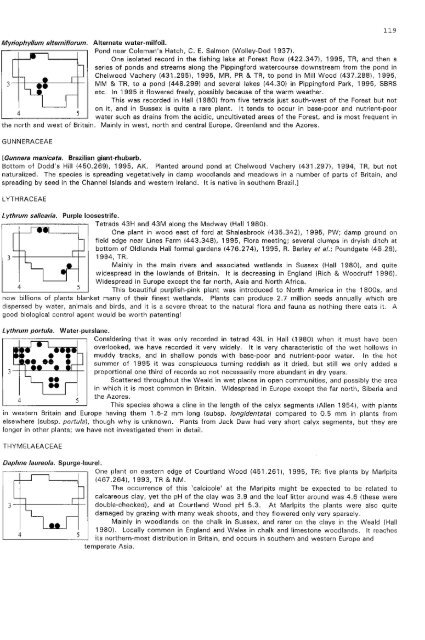Flora of Ashdown Forest - Botanical Society of the British Isles
Flora of Ashdown Forest - Botanical Society of the British Isles
Flora of Ashdown Forest - Botanical Society of the British Isles
You also want an ePaper? Increase the reach of your titles
YUMPU automatically turns print PDFs into web optimized ePapers that Google loves.
Myriophyllum alterniflorum. Alternate water-milfoil.Pond near Coleman's Hatch, C. E. Salmon (Wolley-Dod 19371.One isolated record in <strong>the</strong> fishing lake at <strong>Forest</strong> Row (422.3471. 1995, TR, and <strong>the</strong>n aseries <strong>of</strong> ponds and streams along <strong>the</strong> Pippingford watercourse downstream from <strong>the</strong> pond inChelwood Vachery (431.2951. 1995, MR, PR & TR, to pond in Mill Wood (437.2881, 1995,MM & TR, to a pond (448.2991 and several lakes (44.301 in Pippingford Park, 1995, SBRSetc, In 1995 it flowered freely, possibly because <strong>of</strong> <strong>the</strong> warm wea<strong>the</strong>r.This was recorded in Hall (1980) from five tetrads just south-west <strong>of</strong> <strong>the</strong> <strong>Forest</strong> but noton it, and in Sussex is quite a rare plant. It tends to occur in base-poor and nutrient-poor4 5water such as drains from <strong>the</strong> acidic, uncultivated areas <strong>of</strong> <strong>the</strong> <strong>Forest</strong>, and is most frequent in<strong>the</strong> north and west <strong>of</strong> Britain. Mainly in west, north and central Europe, Greenland and <strong>the</strong> Azores.GUNNERACEAE[Gunnera manicata. Brazilian giant-rhubarb.Bottom <strong>of</strong> Dodd's Hill (450.2691, 1995, AK. Planted around pond at Chelwood Vachery (431.2971, 1994, TR, but notnaturalized. The species is spreading vegetatively in damp woodlands and meadows in a number <strong>of</strong> parts <strong>of</strong> Britain, andspreading by seed in <strong>the</strong> Channel Islands and western Ireland. It is native in sou<strong>the</strong>rn BrazilJLYTHRACEAELythrum salicaria. Purple loosestrife.Tetrads 43H and 43M along <strong>the</strong> Medway (Hall 19801.One plant in wood east <strong>of</strong> ford at Shalesbrook (435.3421. 1995, PW; damp ground onfield edge near Lines Farm (443.348), 1995, <strong>Flora</strong> meeting; several clumps in dryish ditch atbottom <strong>of</strong> Oldlands Hall formal gardens (476.2741. 1995, R. Barley et al.; Pound gate (48.281,3 1994, TR.Mainly in <strong>the</strong> main rivers and associated wetlands in Sussex (Hall 1980), and quitewidespread in <strong>the</strong> lowlands <strong>of</strong> Britain. It is decreasing in England (Rich & Woodruff 1996).Widespread in Europe except <strong>the</strong> far north, Asia and North Africa.4 5 This beautiful purplish-pink plant was introduced to North America in <strong>the</strong> 1800s, andnow billions <strong>of</strong> plants blanket many <strong>of</strong> <strong>the</strong>ir finest wetlands. Plants can produce 2.7 million seeds annually which aredispersed by water, animals and birds, and it is a severe threat to <strong>the</strong> natural flora and fauna as nothing <strong>the</strong>re eats it. Agood biological control agent would be worth patenting!Lythrum portula. Water-purslane.Considering that it was only recorded in tetrad 43L in Hall (1980) when it must have beenoverlooked, we have recorded it very widely. It is very characteristic <strong>of</strong> <strong>the</strong> wet hollows inmuddy tracks, and in shallow ponds with base-poor and nutrient-poor water. In <strong>the</strong> hotsummer <strong>of</strong> 1995 it was conspicuous turning reddish as it dried, but still we only added aproportional one third <strong>of</strong> records so not necessarily more abundant in dry years.Scattered throughout <strong>the</strong> Weald in wet places in open communities, and possibly <strong>the</strong> areain which it is most common in Britain. Widespread in Europe except <strong>the</strong> far north, Siberia and<strong>the</strong> Azores.This species shows a cline in <strong>the</strong> length <strong>of</strong> <strong>the</strong> calyx segments ~Allen 1954), with plantsin western Britain and Europe having <strong>the</strong>m 1.5-2 mm long (subsp. longidentata) compared to 0.5 mm in plants fromelsewhere (subsp. portula), though why is unknown. Plants from Jack Daw had very short calyx segments, but <strong>the</strong>y arelonger in o<strong>the</strong>r plants; we have not investigated <strong>the</strong>m in detail.THYMELAEACEAEDaphne laureola. Spurge-Iaurel.One plant on eastern edge <strong>of</strong> Courtland Wood (451.2611, 1995, TR; five plants by Marlpits(467.2641. 1993, TR & NM.The occurrence <strong>of</strong> this 'calcicole' at <strong>the</strong> Marlpits might be expected to be related tocalcareous clay, yet <strong>the</strong> pH <strong>of</strong> <strong>the</strong> clay was 3.9 and <strong>the</strong> leaf litter around was 4.6 (<strong>the</strong>se were3 -1---1-------1.--1- double-checkedl, and at Courtland Wood pH 5.3. At Marlpits <strong>the</strong> plants were also quitedamaged by grazing with many weak shoots, and <strong>the</strong>y flowered only very sparsely.4 5Mainly in woodlands on <strong>the</strong> chalk in Sussex, and rarer on <strong>the</strong> clays in <strong>the</strong> Weald (Hall1980). Locally common in England and Wales in chalk and limestone woodlands. It reachesits nor<strong>the</strong>rn-most distribution in Britain, and occurs in sou<strong>the</strong>rn and western Europe andtemperate Asia.119
















